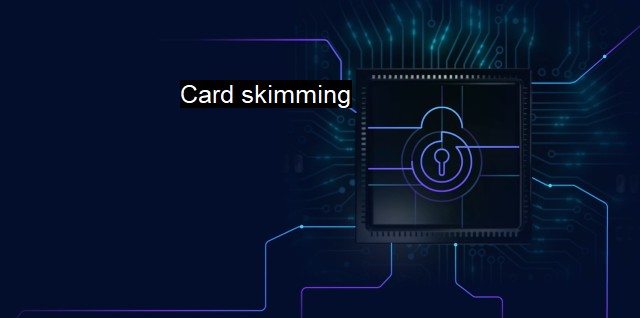What is Card skimming?
Card Skimming: Understanding This Cyber Theft Technique and Its Threats to Financial Security and Privacy
Card skimming is a blanket term used in cybersecurity circles to describe the unauthorized and malicious acquisition of data from the magnetic strip of credit, debit, or ATM cards. This type of security breach is a global problem and is becoming increasingly prevalent with advancements in technology. Specifically, skimming happens when thieves utilize stealthy electronic devices, often attached to legitimate card readers like ATMs or gas pumps, to steal card information.There are many types of skimming devices, some overt, others more covert both physically and technologically. The most common variant is a "skimmer," a small gadget that can be effortlessly installed in or on a valid card payment terminal, and that copies a card's details when swiped or inserted. Skimmers are usually combined with either a hidden camera or a keypad overlay that intercepts the input of a customer's Personal Identification Number (PIN), providing unauthorized parties both with the physical data from the card’s magnetic strip and the PIN.
Another form of card skimming involves a handheld gadget used by dishonest merchants. In a crafty sleight of hand, they'll swiftly swipe your card to capture your data while pretending to process an otherwise legitimate transaction.
Once the skimmer has gathered the card details, the information is stored or transmitted to the criminals. They either assemble clone cards to perform fraudulent transactions or sell the data on the dark web to even more sinister actors executing large-scale fraudulent operations. The stolen information could cause significant loss, damage, and anxiety to individuals who may spend precious time and significant sums of money undoing the damage caused by such crimes.
Organizations dedicated to combating card skimming have made considerable progress in adopting countermeasures to these types of attacks. Unfortunately, these fraudulent practices evolve almost as quickly as the protective measures designed to thwart them. As such, many institutions are twilighting the use of magnetic stripes by favoring chip-based systems like EMV, which provides better security. not all merchants implement chip readers due to costs, leaving room for skimming to continue.
It is important to note, card skimming does not only risk the individual's finances but also significantly affects global financial security and stability, a perennial concern for financial institutions, cybersecurity experts, and law enforcement agencies around the world.
Given the ubiquitous threat and potential damage of card skimming, individuals should focus critically on safeguarding their sensitive information. Tools and technologies, notably advanced antivirus software, can secure private and personal information. Antivirus software could serve as a holistic internet security measure, often equipped with features to notify the user about potentially malicious websites or detect keyloggers (a type of software that records keystrokes to steal information like logins).
Luckily, vigilance can also serve as effective armor against this rampant violating practice. Cardholders should observe card payment terminals and resist using those that seem tampered with or compromised. Regularly monitoring card statements for unfamiliar charges is another effective defense as early detection can minimize the damage done. Not disclosing card PIN to any third party under any circumstances is another layer of security in the individual's arsenal.
Card skimming represents a tangible and ever-looming threat in the present digital finance landscape. It is a form of deception that unveils appalling vulnerabilities in systems designed to maintain and enforce trust between individuals and financial institutions. by implementing rigid cybersecurity measures, advancing the quality of antivirus security systems, and through personal diligence, card skimming’s relentless growth can be held back, creating a safer environment for the financial wellbeing of all.

Card skimming FAQs
What is card skimming?
Card skimming is a type of cybercrime where perpetrators use electronic devices to steal personal and financial information from the magnetic strip of credit or debit cards.How does card skimming happen?
Card skimming happens in various ways. It can occur when using an ATM or a payment terminal that has been tampered with by scammers. The device attached to the machine reads the card information, which later gets used fraudulently.How can we prevent card skimming?
There are several measures to prevent card skimming. One of the ways is by using antivirus software on devices that store personal and financial data. It's also crucial to check for suspicious devices before using an ATM or payment terminal. Additionally, using tap-and-go payment options or chip-and-pin technology lowers the risk of card skimming.What should I do if I suspect that my card has been skimmed?
If you suspect that your card has been skimmed, contact your bank or financial institution immediately. It's also necessary to check your account statements for any unauthorized transactions and notify your bank of such instances. Reporting instances of card skimming to the authorities can help in preventing further incidents.| | A | | | B | | | C | | | D | | | E | | | F | | | G | | | H | | | I | | | J | | | K | | | L | | | M | |
| | N | | | O | | | P | | | Q | | | R | | | S | | | T | | | U | | | V | | | W | | | X | | | Y | | | Z | |
| | 1 | | | 2 | | | 3 | | | 4 | | | 7 | | | 8 | | |||||||